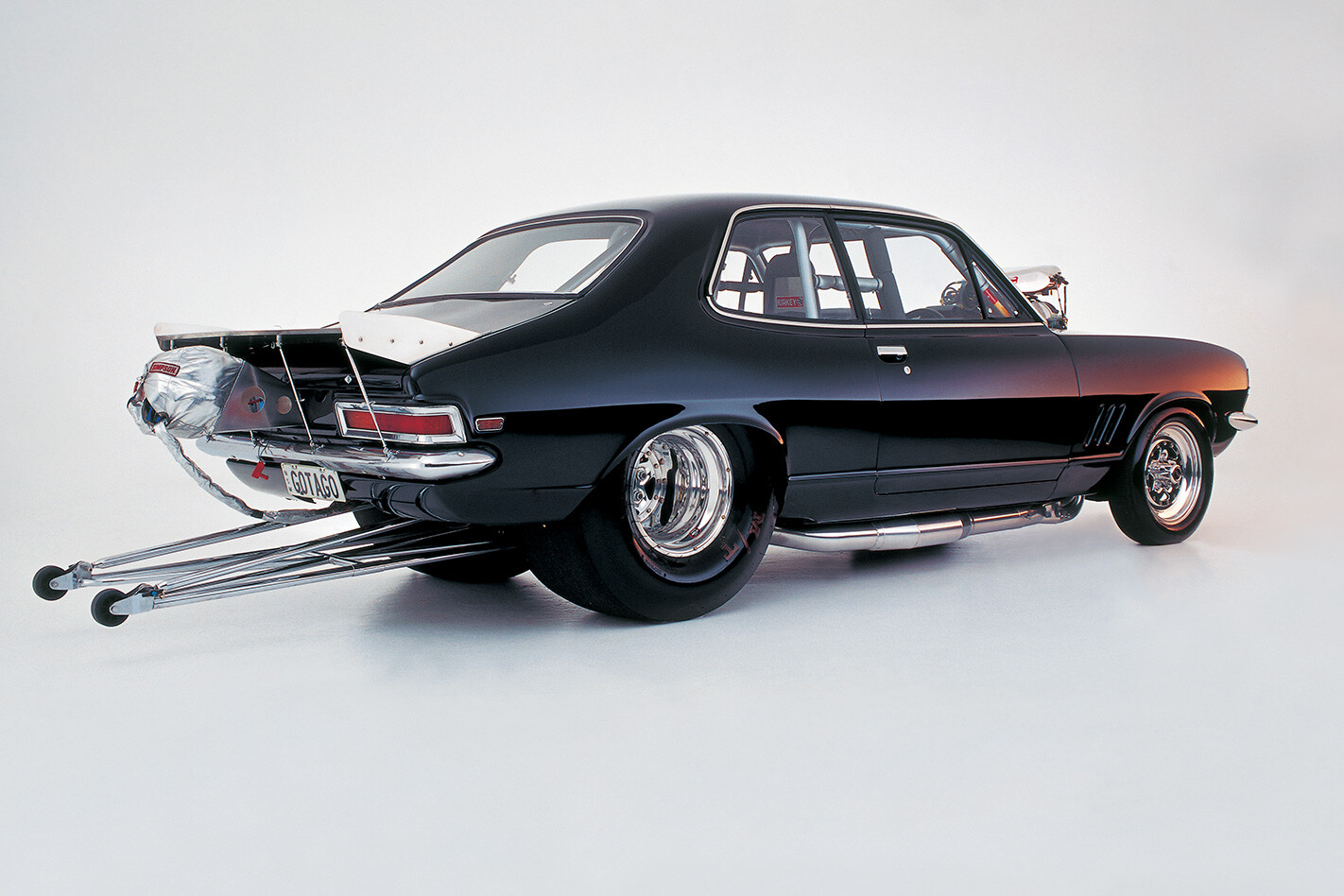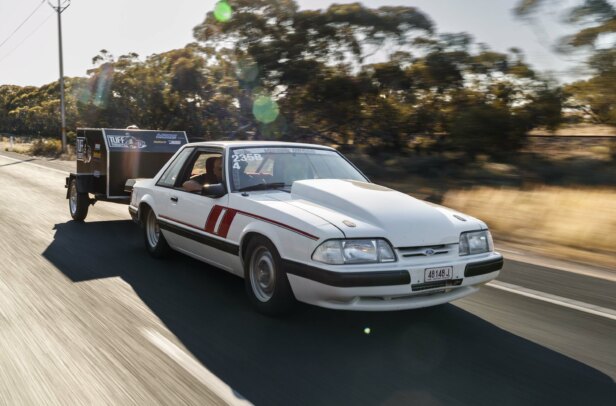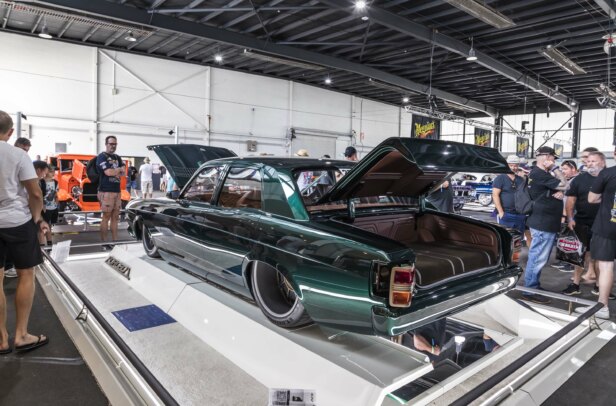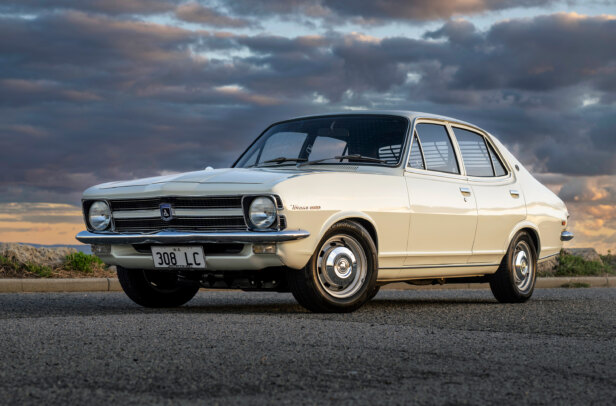LOVE your Holdens? We certainly do, especially when they’re turned out like Peter Flynn’s monster. However, forget what the badge on the side of the car says because the only thing left in this baby that’s Holden is the floorpan, front end and a few panels; the rest is 100 percent performance and billet muscle.
First published in Street Machine’s Holden Legends issue no.3
Step on the loud pedal of this puppy and you’ll feel like you’ve been slammed up the rear by a freight train pulling the ton. And if you expect to pull up beside Peter at the lights on Parramatta Road on Saturday night, think again, this rig’s playground is the quarter-mile black top.
Capable of punching out 1700 horsepower and more than 1000ft/lb of torque with a terminal speed towards the 200mph mark, the void between this LC and your average 10-second street Torana is big enough to sail the QEII through. And for the uninitiated, you’d want to have balls as big as melons to drive all 1700 ponies to the limit.
Peter is no stranger to tough cars and with six kids (yes six!) a wife and a garage full of toys that include a twin-turbo V-Spec R34 Nissan GTR, a 10-second small-block-powered Torana and, before buying this shell as a roller, he owned a blown-injected candy-apple LX hatch that stopped the clocks with an 8.6 over the quarter-mile. So how does he do it? Hard work and 13-hour days, says Peter.
His need for speed was further fuelled by lifetime mate Joe Cutelli, who has successfully campaigned a mid-seven-second LJ in the Pro Street scene for the past few years, and together they have high sixes in their sights.
With word of a tidy LC roller up for sale Peter sold the hatchback and then he and Joe sat down to work out a strategy for building a dream car, but found they had some work ahead of them upon taking delivery of the shell. Although the car had recently graduated from a chassis shop in Sydney, the boys were quick to discover that the rear of the car required some serious reworking to cope with what they were going to throw at it.
The whole project got down to number crunching. To run mid-sevens the engine had to make 1500hp, the car had to weigh not more than 2600lb (with driver) after being tubbed, caged, gutted and tinned-out, and there had to be at least a 33×14½ tyre under the arse.
Take a look under the car and what you see is nothing like what the factory built. The whole floorpan from sill to sill and back to the rear apron has been removed. A half chassis in box section was grafted to the original frame and a four-link built. From there it’s a matter of filling in the gaps with alloy to keep the weight down.
The car came with a race-style set-up but most of the rear-end and wheelie bars were replaced with chrome-moly tube and hymie joints.
The diff is a braced Ford nine-inch with nodular centre, 40-spline Mark Williams axles and components, 4.3:1 gears, full spool, alloy pinion support; Commodore brakes and front and rear yokes and shaft are also Mark Williams.
“We bought the car with one thing in mind,” says Peter, “and that was to go fast. We knew we were going to run a seven and we’re hoping it’s a mid seven.”
In the mumbo department the engine was originally built by Santos and freshened by Aussie racing legend Mark Brew. The engine is a small-block Chev Rodeck with steel caps, 4in bore and a Cola crank with 3½in stroke. Conrods are six-inch GRP aluminium with JE slugs, and camshaft is a Crane roller ground especially for Santos and only available through Santos. Heads are Brodix Dash 12s with titanium valves, collets and retainers and other trick hardware includes Jessel rockers with a Jessel belt drive and a Santos-built sheetmetal intake.
In the intake department a retro and tefloned 10/71 replaces the original 14/71 blower and with 28 percent overdrive makes 30lb of boost supplied through an Enderle Superbird with a 110 pump. Ignition is a Supermag IV punching out four amps with 10mm leads.
The engine almost looks factory in the gloss-black engine bay and the assortment of billet hardware really wouldn’t be lost on anyone who has any appreciation for cars. Other mods to the engine bay include an 18-litre front header tank to hold alcohol, an alloy radiator, tranny cooler and dual puke tanks by Mick’s Metalcraft.
Fabricating whiz Peter Cleary got the nod to build the pipes with 2¼-inch primaries that flow into 4½-inch collectors, through dual Gonzo Mufflers and dumped at the diff.
A two-speed Powerglide built in the USA and good for 1800 ponies is bolted to the little-block and the cost of go-fast bits in the box alone are enough to build a quick street car. The standard case has been ditched for a Dedenbear case fitted with Vasco input shaft, twin-ring servo, extra clutches in top gear, 1.76:1 Vasco planetary set, TCI valvebody and every other bulletproof bit available for a Powerglide. Converter is homegrown and a huge 11-inch item direct from Phil Sodostrom at PTC, and stalls to around 4000rpm out of the hole.
Inside the car the interior is a work of art. The standard six-point cage was replaced with a full chrome-moly funny car-style cage and the seats are all-alloy full-wraparound Kerkeys with covers. Like the rest of the car the interior was gutted to bare metal – even the pedal assembly has been tossed and replaced with a Wilwood unit with dual master cylinders and brake-proportioning valve. Shifter is a B&M Pro Ratchet and the alloy dash fitted with just three gauges to report engine vitals: oil pressure, water temperature and boost.
With only a few passes to date, as a result of a soft tune to get all the bugs ironed out, the car has already run a 7.8@175mph all over the track.
“The car was a real handful to drive so we had it squared-up and had a new roll cage fitted after running the 7.80. It feels like a new car now,” says Peter.
“We’ve been treading lightly to date, it’s rich as a pig, a new engine, new car and a whole new combo. But wait until next time we take it out. I think we’ll get even more respect at the track; we haven’t been leaning on it but now it’s time to – you will really see where the money has been spent.
“We’ve only been turning the engine up to about 8600rpm but now we’re going to start turning the engine up to 9800. Brewy used to turn a similar combo to about 10,500rpm with a PSI on it.
“Stand on the loud pedal and it just goes. Before you know it you’re wondering how to get off the ride and you are pulling ’chutes and standing on the brakes.”
Networking with the right people is what makes this car so exciting. No expense has been spared and the quality of workmanship is breathtaking. Without access to so many talented people a car of this nature could never have happened and Peter would like to thank Joe Cutelli for his mateship and tireless help with building the car, Geoff Ramsey who just gets on with the job, Mark Brew for his endless support, Peter Miller, Joe Lipari from Hi-Speed Auto Electrical and his wife Robyn and children for being so understanding.
RODECK BLOCKS
RODECK alloy blocks are available in a number of configurations but their main features include thicker pan rails, thicker webbing around the main caps, beefier decks on the block and in a number of other variations, including raised and standard cam tunnels to allow for rod and crank clearance with big-stroke engines. The blocks are made in the USA by Rodeck Aluminium Blocks Incorporated in Paso Robles, California, and retail for about $12,000. They are available through Performance Wholesale in Brisbane on (07) 3808 1986.
OZ’S FASTEST STREET CAR?
ALLOY blocks or any block that cannot accept all factory accessories including sump, water and oil pump and heads are not permitted in Pro Street. Blocks must run water and be of standard design and internal configuration. As such, Peter’s car does not qualify but if it had a cast-iron block and produced the same performance it would currently be on pole as Australia’s fastest V8 street car. And, yes, we do realise it’s not actually a street car but like the number plate says, when you’ve got to go you’ve GOTAGO!
1970 LC TORANA COUPE TECH
Colour: Diamond Metallic Tinter
Makin’ It Move
Type: 373ci alloy Rodeck
Crank: Cola billet
ROds: GRP alloy, JE slugs
Heads: Dash 12 Brodix
Induction: Tefloned retro 10/71, Santos sheetmetal intake, Superbird injector
UNDERNEATH
Trans: Powerglide
Diff: Braced Ford 9in, 4.3 gears
ROLLIN’
Wheels: 15×14 Alumastar
Tyres: 33×14½ Mickey Thompson (r), 15×4 Frontrunners (f)




Comments